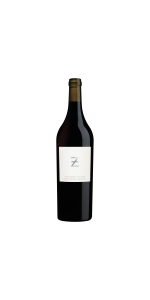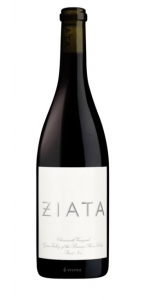Wine from Ziata

After 20 years of marketing Napa Valley and its wines, Karen Cakebread launched ZIATA Wines in 2008. “I had two goals: to create beautifully structured wines that reflect the vineyards they come from; and to be involved in every aspect making wine.” She named the brand in honor of her mother, Mary Annunziata.
Despite the pull of wanderlust, Karen’s roots are firmly planted in Calistoga, where she tends to her Sauvignon Blanc vines at the home ranch, with her affable Labrador Neela by her side.
The driving force behind boutique Napa Valley label ZIATA, Karen Cakebread relishes every small step that brings a wine from vineyard to table. The Palo Alto native may as well have been born in wine country—there’s no truer home than Napa Valley for this industry veteran.
Karen launched ZIATA—named for her beloved mother Mary Annunziata Webb—in 2008 with a widely revered Sauvignon Blanc and Pinot Noir. Today, the collection also includes the Mia Madre Red Blend, a moving tribute to Karen’s mom. Embarking on her own business venture gave Karen the opportunity to become immersed in every aspect of guiding a wine from vine to bottle to table. Depending on the day, that may mean vineyard sourcing and blending or package design and marketing strategy.
“Creating ZIATA gave me this outlet for all of my passions,” said Karen. “Choosing where we source our fruit, working closely with our growers and our winemaker, building strong connections with our customers—I love being able to put my personal touch on all of it.”
Karen came to Napa by way of Silicon Valley’s high-tech sector nearly 30 years ago. Her first foray into the wine industry came in 1988, when she began marketing Cakebread Cellars wines. Her role spanned 18 years and would see Karen traverse the globe as director of the winery’s corporate hospitality, wine education and international marketing initiatives.
An avid supporter of the nonprofit trade organization Napa Valley Vintners, Karen has served on the association’s board of directors, chaired numerous marketing committees and served as co-chair for Auction Napa Valley, the world’s preeminent charity wine auction. A founding board member and past president of Calistoga Winegrowers, Karen is a tireless advocate for the land and wines of Napa Valley. She also serves on the boards of both the St. Helena Hospital Foundation and UpValley Family Centers of Napa Valley.
Beyond ZIATA, Karen nurtures a sense of adventure and a yearning to explore the world. Her travels have taken her to Nepal, Turkey, Mongolia, Africa and India. And not just as a passive tourist—she has scaled Mt. Kilimanjaro with a group of like-minded Napa Valley women who trek mountains in far-flung locales to raise funds for breast cancer research.
Ziata Meteor Vineyard Cabernet Sauvignon is made from 100 percent Cabernet Sauvignon.
Bold and intense, this Cabernet Sauvignon from the Meteor Vineyard in Coombsville is full-bodied and berry-driven, with rich spice undertones and a firm structure.
After 20 years of marketing Napa Valley and its wines, Karen Cakebread launched her own project in 2008 with two major goals in mind: to create beautifully structured wines that reflect the vineyards from which they come, and to be involved in every aspect of making the wines.Karen started ZIATA, named in honor of her mother, Mary Annunziata, in 2008 with three varietals: Cabernet Franc, Sauvignon Blanc and Pinot Noir, which she chose for their food-friendly qualities. She hired Anne Vawter, a protégée of Heidi Barrett, as winemaker and sourced grapes from sustainable sources, working closely with the grape growers through the growing season, knowing that efforts made in the vineyard would create better wine than those manipulated in the cellar. Jennifer Williams : I find winemaking to be both an art and a trade—you learn by doing and working the vineyards, ensuring the fruit is the best it can be long before it’s picked is at least half the work of the winemaker.
Ziata Pinot Noir Russian River Valley is made from 100% Pinot Noir.
Vineyard Notes
Green Valley is tightly delineated geographically and climatically, and is the most consistent Sonoma Coast appellation in terms of soil, climate and flavor profile. Two factors, in particular, make it ideal for Pinot Noir. First, the predominant soil type is Goldridge, which with its excellent drainage and low fertility, curtails the vine’s vigor. This results in fewer clusters but of better quality. Second, its elevation and cool coastal climate mean a smaller swing between and day and night temperatures, and its overall cooler daytime temperatures allow for a longer growing season to bring out the full potential of the fruit.
Tasting Notes
This silky Pinot Noir opens with aromas of fresh strawberry, cherry, raspberry and plum, warmed by notes of spice, forest floor and cedar. The wine is fresh and balanced on the palate, with fruit and beautifully integrated oak flowing into a long, juicy finish.
Production Notes
This was the third year of drought, but well-timed watering in the vineyard ensured ample growth and cluster development. Rolling heat spells prior to harvest were kept in check by cool nights, courtesy of the nearby Pacific Ocean. This diurnal range resulted in a medium-bodied, juicy gem of a Pinot Noir.
- back
Selected Options
Wineries
Categories
Pricing
Countries
Regions
Grape Types
Wineries
Organic/Free Shipping
Alain Jaume Gigondas Terrasses de Montmirail is made from 65% Grenache the rest Syrah, Mourvèdre by less than 15%.
Deep red garnet color. Aromas of ripe and black fruits. On the palate the wine is rich, powerful and harmonious - well balanced with wild berry and pepper dominating.
Soil types
Located in and around the famous area called “Dentelles de Montmirail”, the landscape typicity is made by a rocky bar (between 100 and 600 meters high). Soils are made of clay and sand with limestone. The “Dentelles” appeared thanks to the pressure between the Pyrenees and Alps mountains. This is a land of predilection to produce both powerful and fresh wines. Nights are cooler and the grapes ripeness usually comes in late September.
Winemaking & aging
Traditional wine-making in stainless and concrete vats. Crushed and destemmed grapes. Average of 18 days of vatting with pigeages. Ageing in vats mostly and oak barrels. Bottling after 12 – 14 months.
Chateau La Nerthe Chateauneuf-du-Pape Rouge is made from Grenache 39%, Mourvédre 33%, Syrah 25%, Cinsault 2%, Others 1%.
Château La Nerthe is one of the oldest estates in Châteauneuf-du-Pape and dates from 1560. Château La Nerthe has 227 acres of vineyards that surround the château and top the renowned La Crau plateau. The terroir is typical of the region. Vineyards run along a slope and grow in sandy-clay soils. The ground is covered by a layer of ‘galets’ – large, round, well-worn stones that were carried down from the Alps by glaciers during the last ice age. All the 13 permitted primary varietals are planted here. Grenache dominates 62% of the vineyards and the average vine age is over 40 years old. The grapes are hand harvested and sorted on tables. The grapes are then put into vats for almost 4 weeks with regular pump overs and punch downs. The must is tasted every day during fermentation to ensure the best extraction of the berry compounds. At the end, the wines are racked into oak vats for malolactic fermentation. The cuvée is then aged in large French oak casks and barrels for 12 months before blending. Bottling takes place 6 months later.
The dark, deep, inky color of the wine shows immediately, stemming from the concentration of the vintage. Nose of blackcurrants, black tea and dried flowers stands out. The mouth is rich, fruity and velvety with an incredibly layered tannic structure. The wine is balanced and pure with strong intense and incredibly long aging potential.
- One of the oldest estates in Châteauneuf-du-Pape - dates from 1560
- Estate grown, hand harvested, estate bottled
- Average vine age is 40+ years
- Certified AB Organic
Review:
A focused expression, this wine delivers pure red and black fruits unfolding against a delicate rose-petal backdrop. Silky yet chewy tannins gradually reveal layers of red cherry, pomegranate, spice, violets, and a hint of clove. Its elegance is underscored by fine tannins, suggesting a wine that, while quiet now, holds the promise of revealing its full beauty with time in the bottle. Cellaring through 2028+ before revisiting should prove to be rewarding.
-Wine Enthusiast 93 Points






